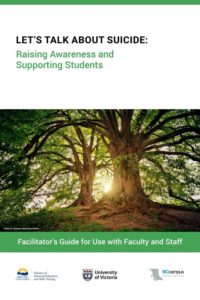A new tool has been made available for staff and faculty of BC colleges and universities to support students on campus who are dealing with mental-health crises.
Let’s Talk about Suicide: Raising Awareness and Supporting Students is a digital resource made available by BCcampus. University of Victoria Student Wellness Centre manager of mental health outreach and training Dawn Schell is the author of the original training that was adapted for the new resource, and she wants to keep the conversations going. She says that there are a number of resources out there available to help in the moment if someone is feeling suicidal.
“Sometimes in the long-term follow up, it can be a bit of a waiting game, but that immediate, in-the-moment support is so important for people,” says Schell. “It can help with that stop-gap that can be a really good connection while people are waiting for those longer-term resources that may be more helpful.”
Schell says that there are a number of signs to look for when you think someone may be feeling suicidal.
“There are kind of three things I am really looking for and paying attention to,” she says. “It’s a mixture of feelings. If somebody feels helpless; if they feel hopeless; if they feel worthless. Those are really big red flags to me, if someone makes a statement like that. If they’re showing those things, that’s a big indicator for me to say, ‘Hey, what’s going on?’”
Schell also acknowledges how difficult it can be to reach out.
“It’s challenging when you’re in that state to think clearly for yourself, to make those connections,” she says. “When I do presentations around here at UVic, around suicide awareness, I do them for student leadership groups, like our community and residents but also for our staff and faculty particularly, to really know what to pay attention to. To know how to initially respond effectively about some of the things I have focused on about suicide awareness, to talk about some of the myths about suicide. I’m creating more awareness and community because I am having people engage in conversations.”
Schell says that we need to break the stigma by having people talk more openly, and also talk about the available resources and support. She says the resources and support aren’t always perfect “but at least there are many different ways and options that keep people trying.”
“It’s also up to us as friends, as supporters, our loved ones to keep encouraging to connect until we find what will work for them,” she says.
Schell says that international students can sometimes be at higher risk.
“Some recent research shows that there is a higher risk group, because there [are] less supports here, they have less community here, have left their familiar supports at home,” she says. “That is why it is so important to emphasize that there is no shame ever in talking about suicide. One important support available is here2talk.ca, as well as there is an Indigenous helpline for young adults and youth, and I know that people who have reached out to those have had positive experiences. You know there is a suicide risk curve, so if we can buy some time, the intense feeling that they’re feeling may dissipate. That is the point where things seem a bit clearer so you see what the next step is.”
Schell says the important thing is to start the conversation.
“When somebody feels like they don’t want to ruin anyone else’s day by telling them how they feel, that is when our sense of compassion can really come into play,” she says. “If we can break down those barriers, break down the stigma, we can finally have people say that this is where they’re at, and not feel afraid.”
Let’s Talk about Suicide: Raising Awareness and Supporting Students is available to read at opentextbc.ca/suicideawareness.

